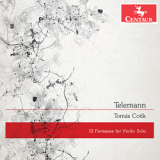Die zwölf Fantasien für Violine von Telemann gehören zu den wenigen überlieferten Werken dieser Gattung aus dem Barock. Allein schon die Bezeichnung Fantasie deutet auf eine freiere Handhabung als die Sonate. Allerdings bleibt auch Telemann weitgehend drei oder vier Sätzen treu. Die Sätze werden vorwiegend mit Tempobezeichnungen überschrieben, gelegentlich als Tanzsätze. Die Schlusssätze geben jeweils eine virtuose Schablone, die mit persönlicher Interpretation zu füllen ist.
Tomas Cotic beschreibt im Beiheft seine Ideen. Neben einem Barockbogen hat er weichere synthetische Saiten verwendet und die Stimmung mit 440 Hertz nahe am heute Üblichen gelassen. Bei der Intonation zieht er reine Quinten und Quarten vor und passt Terzen und Sexten intuitiv an, wenn dies in Akkorden erforderlich ist. Viele weitere Überlegungen erschließen sich bei der Lektüre des Textes.
Praktisch schafft Cotic ein in seinem Stil einheitliches Kompendium, das trotzdem jedem der 44 Sätze seinen Charakter gibt. Cotic folgt der Idee, dass diese Werke für ein Soloinstrument, wenn hier auch auskomponiert, eigentlich zur freien Improvisation gedacht waren. Insofern bedient er sich einer Reihe von interpretatorischen Mitteln, um einen spontan wirkenden Erzählstrang, auch mit Stopps und Wegmarken, zu gestalten. So erzielt er ein insgesamt lebendiges Klangbild. Mancher Halt mag dann überraschen, manche Virtuosität, gerade in den Schlusssätzen, hat eine an übereifriges Eilen grenzende Intensität. Aber Cotic schafft es durchweg, seine Ideen verständlich umzusetzen und bietet so alles in allem eine hörenswerte Sicht auf diese Sammlung.
The twelve fantasies for violin by Telemann are among the few surviving works of this genre from the Baroque period. The designation fantasia alone indicates a freer style than the sonata. However, Telemann also remains largely faithful to three or four movements. The movements are predominantly headed with tempo markings, occasionally as dance movements. The final movements each give a virtuosic template to be filled with personal interpretation.
Tomas Cotic describes his ideas in the accompanying booklet. In addition to a baroque bow, he has used softer synthetic strings and left the tuning at 440 hertz, close to what is common today. In intonation, he prefers pure fifths and fourths and intuitively adjusts thirds and sixths when necessary in chords. Many other considerations become apparent when reading the text.
Practically, Cotic creates a compendium that is uniform in style, yet gives character to each of the 44 movements. Cotic follows the idea that these works for a solo instrument, though here composed out, were actually intended for free improvisation. In this respect, he employs a number of interpretive means to create a narrative thread that seems spontaneous, even with stops and waymarks. In this way he achieves an overall lively sound. Some stops may then surprise, some virtuosity, especially in the final movements, has an intensity bordering on overzealous haste. But Cotic manages throughout to implement his ideas in a comprehensible way, and so all in all offers a view of this collection worth hearing.
























